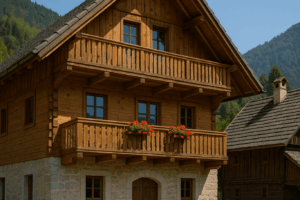Vernacular Architecture in Slovenia
Vernacular architecture or traditional folk building, represents a form of construction that emerged as a response to the natural, cultural, and social conditions of a specific environment. In Slovenia, this type of architecture is remarkably diverse, reflecting the country’s varied geography, climate, and historical influences across different regions.
Slovenian vernacular architecture developed indigenously, without the involvement of professional architects or formally trained experts. The builders were typically local inhabitants who used locally available materials – wood, stone, clay, straw – and followed traditions and the practical needs of rural life.
In modern times, vernacular architecture is often used as inspiration for sustainable design, offering many solutions that harmonize with nature, space, and community.
Key Characteristics of Vernacular Architecture in Slovenia:
Regional Diversity: Alpine houses with wooden balconies in the Gorenjska region, stone houses with slate roofs in the Karst region, and Pannonian houses with clay-rendered facades and thatched roofs.
Functionality: Buildings were constructed with usability in mind – from living quarters to agricultural and utility buildings.
Ecological Approach: The use of renewable materials and techniques that were energy-efficient and environmentally friendly.
Aesthetic Value: Although traditional, these homes possess a unique charm – whether through details, layout, or decorative elements.
Galerija
- Archistudio Blanka de Far


